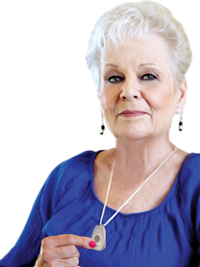Excerpted from an article by Matthew D. Bennett, Public Policy Director, Alliance for Public Technology (Letter No. 8, February 5, 2004)
The following piece discusses ways in which broadband technology can and will bring more advanced services into the home. Below, we have excerpted their discussion to focus on the areas of telemedicine, public safety, emergencies, and seniors. Many experts predict broadband applications will make useful and even life-saving services available to all areas of the country -- many of which were, in the past, only available in urban centers such as New York and other big cities. The upshot is that many senior citizens nationwide, thanks to broadband, will now be able to do more at home, and feel safer at home, for many productive years.
--Dr. Don Rose, Writer,Life Alert
Introduction
For all the sound and fury about city fiber projects, most of the debate around services focuses on doing what we do now, only more of it and faster. Zippier internet? Sure. More video channels? Of course. More responsible customer service? We certainly hope so. But what about all the things that true broadband will allow that simply aren’t possible at DSL or cable modem speeds? The article abstracted below focuses on these “advanced services”.
Not just the same only faster — rather, the impossible made routine…
“Broadband is the word of the day. Highspeed, high-capacity, always-on, interactive services are universally regarded as the future of telecommunications. The potential for broadband is enormous. The applications made possible, such as telemedicine, distance learning, real time sign language interpreting and others, offer innovative ways to live, work and learn.”
“There is no single ‘killer’ application. In fact, there are countless applications that are tremendously valuable. For a patient in rural Georgia who needs specialized health care from an urban hospital, telemedicine is a killer app. For students in a low-income school district who have textbooks that are older than they are, distance learning that connects them to dazzling research and resources is a killer app. Broadband’s power lies in the flexibility of the technology. It can be used by different people and communities to address different problems in different ways.”
Telemedicine in the home, and elsewhere…
“As more Americans are able to utilize advanced telecommunications technology, telemedicine will continue to grow as a medical tool. The “Electronic HouseCall System” (EHC) was implemented in Augusta, Georgia. “From the home unit, the patient could check his or her pulse, blood pressure, blood oxygenation, temperature, glucose levels and heart function with a modified lead 2 electrocardiogram. This information is then sent to the medical staff.”
“The patient and provider could also interact online through a videoconference. The clinician could use a stethophone to expand examination of the patient. The utility of the system was in many ways tied to available bandwidth. With broadband capability, the EHC system could incorporate a wider array of monitoring tools such as spirometers, fetal heart monitors and uterine activity monitors. Development of advanced health care services is unlikely without dedicated high-speed connections. Current incarnations such as DSL and cable modems are acceptable, but still limit the scope of potential applications. With general bandwidth availability, telemedicine technologies can be used to expand access to medical services and explore the delivery of more sophisticated medical services.”
Public safety
“When a fire alarm is initiated, the firefighters are immediately able to view the optimal route to the location. The city utilized global positioning satellite (GPS) technology to create a street centerline coverage that the computers then use to determine the fastest route to the emergency. The laptops in the emergency vehicles use the Geographical Information System (GIS) applications, which determine the route based on speed limits, one-way streets, turning movements allowed, etc. The GIS software also can alert the firefighters to any impediments on the route, such as downed power lines, and then create an alternate route.”
Rural community development
“The Troup County Senior Center reported that seniors are using the Internet connection to research insurance policies, gather information about medical conditions and interact with other seniors who may have similar conditions, email grandchildren and trace family histories. Local banks have made presentations to the senior groups about online banking. Local businesses reach more customers with the spread of Internet connections.”
“Through the city’s initiative, there is strong use of the telecommunications technology that is so vital today. Community building in the 21st century is no longer solely about traditional infrastructure like roads and houses. Now, the new infrastructure that unites the community via broadband and communications technology is equally critical.”
Delivering the promise
“It is imperative to showcase the applications made possible by the technology so that a greater understanding can be achieved and that efforts can be dedicated to making the technology available and accessible for all. These are the stories of how advanced services enhance lives.”
“If we are to create the connected communities envisioned here, then we must move from a discussion of speed and providers to one of applications and benefits, with an unwavering focus on the public interest. People don’t want to talk about broadband; they want to get their hands on it and use it.”
This article contains excerpts from a work entitled “A Broadband World: The Promise of Advanced Services”, by Matthew D. Bennett. It is covered by a Creative Commons license. SUMMARY OF THE CREATIVE COMMONS ATTRIBUTION LICENSE: You are free to copy, distribute, display, and perform the work; to make derivative works; to make commercial use of the work. Under the following conditions: (1) Attribution -- You must attribute the work in the manner specified by the author or licensor; (2) For any reuse or distribution, you must make clear to others the license terms of this work; (3) Any of these conditions can be waived if you get permission from the copyright holder. Your fair use and other rights are in no way affected by the above. Please go to http://creativecommons.org/licenses/by/1.0/ to view more information about the Creative Commons license that applies to this work.
For more information about Life Alert and its many services and benefits for seniors nationwide, please visit the following websites:
http://www.lifealert.com
http://www.seniorprotection.com
http://www.911seniors.com/






